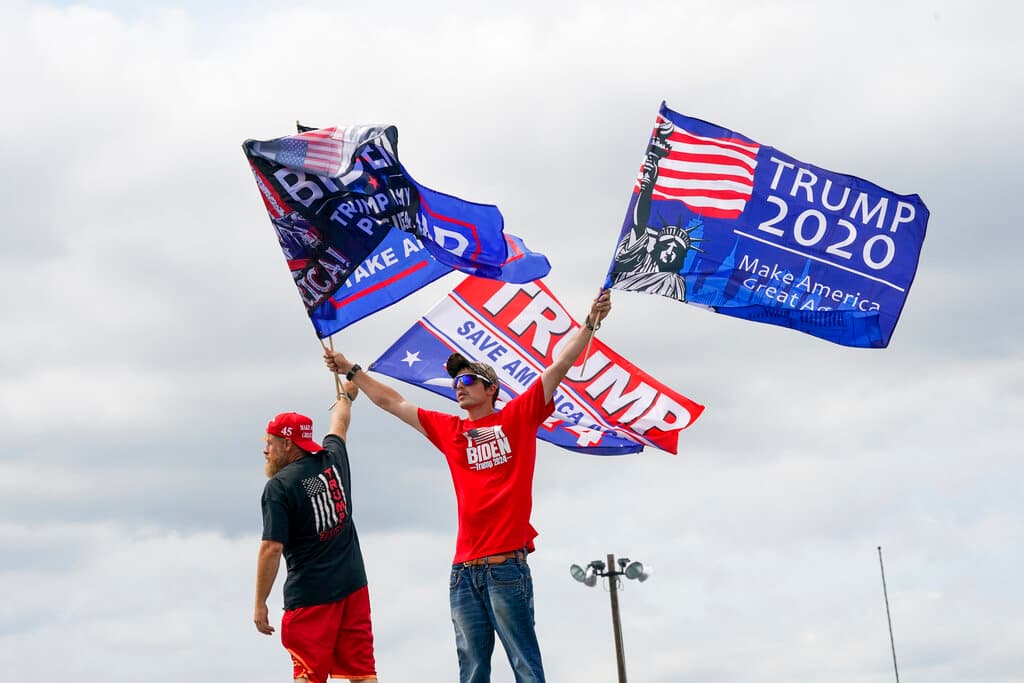The Conservative Populist Movement Is Moving Beyond Trump
‘At some point, it stopped being about the voters, and it started being about his own personal grievances,’ one analyst contends.

NEW ALEXANDRIA, Pennsylvania — Ever since President Trump lost to President Biden in 2020, there has been a flag hanging from a home not far from where I live that reads “Trump 2024” — one of the thousands I have seen across the country in the past two years. But yesterday, when I drove past this home, that sign was gone.
The Trump flag is a phenomenon I have written about for years. I have noted that it wasn’t really about Mr. Trump himself. It was mostly about the conservative populist movement, using the name of its only standard-bearer to let people know they were not going anywhere. At that point, no one else had stepped up to fill the void. And so, the flag bore the Trump name.
When the “Let’s Go Brandon” moment happened, many of those Trump signs were replaced with Brandon signs. If you’ve never understood the conservative populist movement, the significance might escape you. It was always about being a part of something. And for a time, that was about supporting Mr. Trump.
I do not know if the owner removed that flag or whether it fell to the elements after two years because no one opened the door to answer that question for me. But it did make me wonder, one week after the election, when plenty of his voters blamed him for the red wave that fell short, whether that sentiment faded for some of them. Could it be that some or many of Mr. Trump’s die-hards were ready to move on?
What made Mr. Trump inspire voters in places like central Appalachia is that he recognized their strengths, which had been long ignored and often ridiculed by the cultural elite. The media, the political parties, the corporations, Hollywood and academia looked down their noses at ordinary people who live here and basically anywhere more than 20 minutes outside of major metropolitan areas.
These people, however, have their pride. They still hold dear the resourcefulness their parents and grandparents taught them to survive when economic lows creep into their hometowns. They know how to hunt for their meat and smoke it, raise chickens, keep a family budget and work all day with their hands. They rarely expected a handout, let alone believed they were entitled to one or entitled to anything at all.
While many of those voters were a generation away from some of those traditions or crafts their parents practiced, they were still very much part of their cultural identity. Their coalition formed long before Mr. Trump descended that escalator in 2015. He was never the cause; they were already there, just waiting for the right person to speak up for them. He was the result.
They showed up and voted in the midterm elections in 2006 against the Republican establishment. Some of them voted for President Obama in 2008 because of his aspirational message, then voted Republican two years later because he did not live up to the ideals he had run on.
They were uninspired by Senator Romney in 2012, so they sat back — Mr. Obama became the rare president who earned fewer votes in his reelection than he did in his first run. Yet they showed up in force in the 2014 midterm elections, and by 2016, they had settled on Mr. Trump as the only one who understood their potential.
His message was about them, not him. And it worked.
By 2020, that message was all about him. After the election, it was even more about him. But the voters didn’t leave in the way political observers thought they would because there was no one there to fill that vacuum. So, they stayed.
That all started to unravel as governors in Georgia, Florida and New Hampshire showed their prowess in taking on the cultural curators while still being able to govern. When all three of them, along with Governor DeWine in Ohio, won massively in their home states last week, some voters started voicing out loud they were ready to move on.
A lot of them stayed home last Tuesday because of Mr. Trump’s decision to make the midterm election results all about him. They worried his picks would be beholden to his every whim rather than what was important to them, and the red wave died on the vine.
In short, what Mr. Trump started to get wrong is what the media have always gotten wrong about these voters. They do not live by a credo filled with resentment and grievances. Their aspirations are about their communities, families and their future, and that is how they vote.
There is an important nuance in that movement away from Mr. Trump. It is not because they do not appreciate his policies, nor his ability to make people feel it is OK to feel patriotic, nor his impact on the Supreme Court — every one of those supporters interviewed in the past week deeply appreciates that — it’s just that they are ready to move forward.
A South Carolina native and conservative strategist, Bruce Haynes, said there are 900 ways to say it. “When the concept of Trump was that he stood for the grievances of the voters, they were for him,” he said. “At some point, it stopped being about the voters, and it started being about his own personal grievances. And that is when he started losing voters.”
There is another piece of this that is pretty difficult for him, said Mr. Haynes. “A lot of the ethos of Trump was built around winning, but now he’s being accused by some of having a pretty substantial losing streak,” he said.
“That narrative is that he’s never gotten more votes in a general election than a Democrat, lost the House and the Senate in 2018, lost the presidency and now he’s ascribed as losing this year’s midterms. That narrative cuts to the core of his brand.”
The good news for the conservative populist coalition is that it has not fallen apart; in truth, it has grown. It even attracted new Hispanic and black voters. The people the movement will likely peel off are the ones who were infrequent voters before Mr. Trump came along; they were the least ideological and more about Mr. Trump than the rest of the coalition. He didn’t need to win for them; they just liked him because he was a unicorn in a business filled with suits.
Club for Growth, the conservative anti-tax organization, released a series of polls on the same day that Mr. Trump launched his reelection bid from his resort in Florida. The polling memo shows the former president trailing Governor DeSantis by double digits in one-on-one matchups in the early primary voting states of Iowa and New Hampshire, the first two states on the GOP nominating calendar. The survey also showed Mr. DeSantis leading in the Sunshine State and Georgia, where the runoffs will be held next month.
“He used to say ‘they,’ now he says ‘me,’” said Mr. Haynes, “That’s where he’s lost people — he stood for them, and now he’s perceived as standing for himself.”
Creators.com

